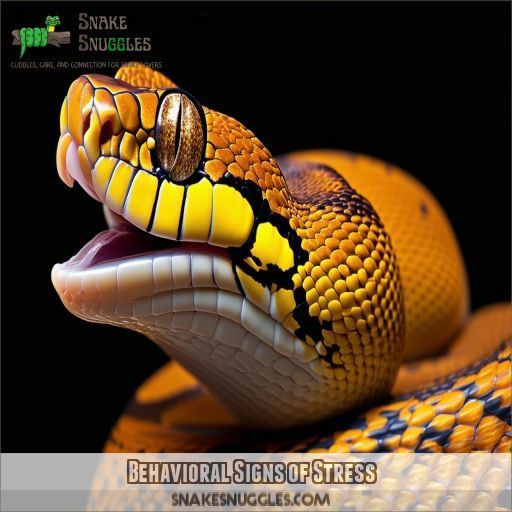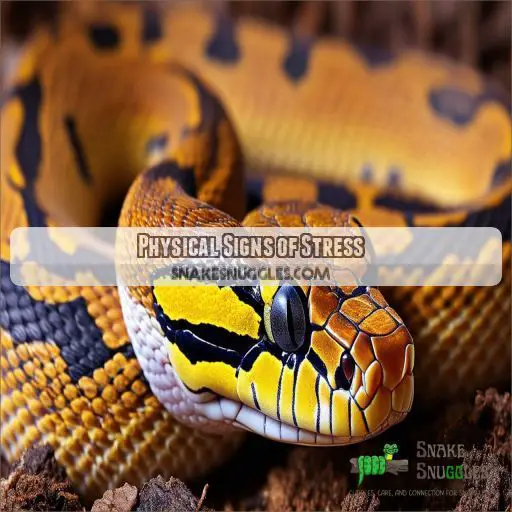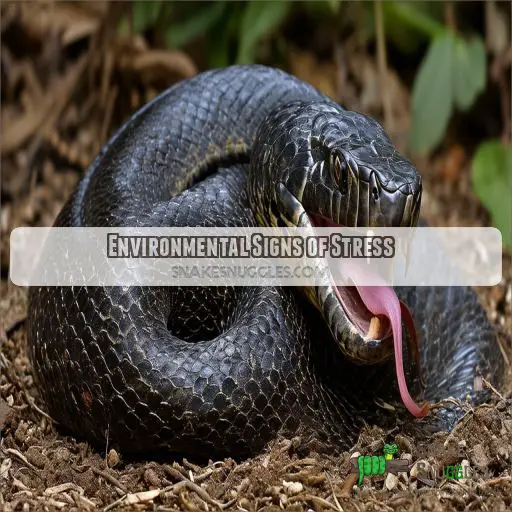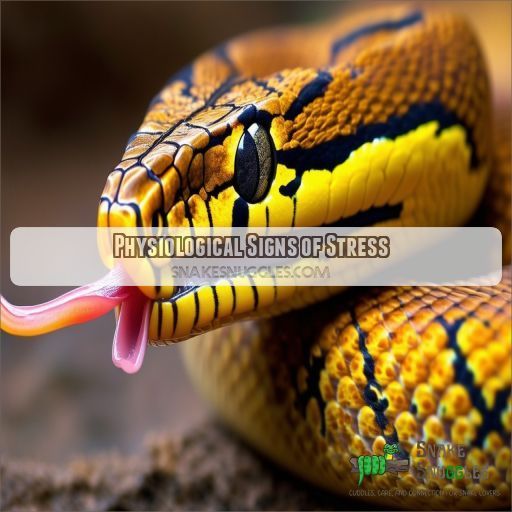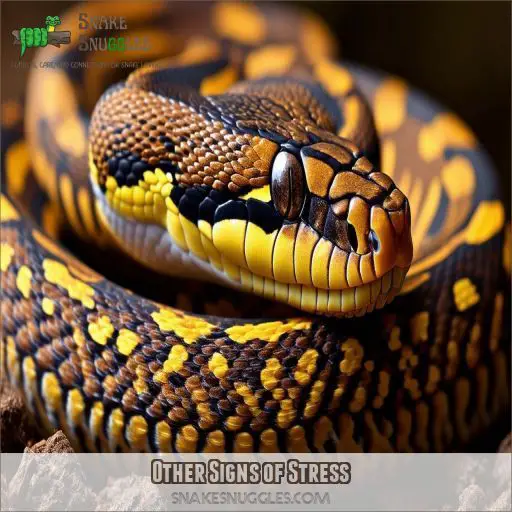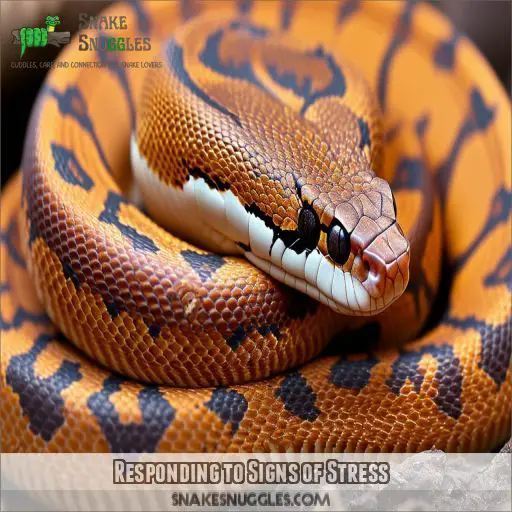This site is supported by our readers. We may earn a commission, at no cost to you, if you purchase through links.
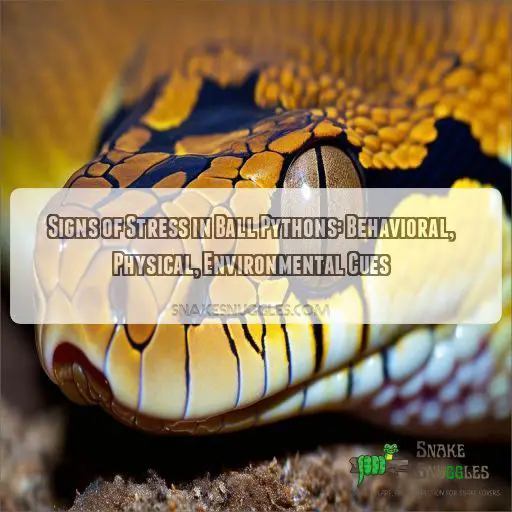 Like a coiled spring, your ball python’s mood can rapidly shift from relaxed to stressed.
Like a coiled spring, your ball python’s mood can rapidly shift from relaxed to stressed.
Knowing the signs of stress is crucial for maintaining your pet’s health and happiness.
From behavioral quirks to physical symptoms, this article will cover a range of stress cues in your snake.
Table Of Contents
- Key Takeaways
- Behavioral Signs of Stress
- Physical Signs of Stress
- Environmental Signs of Stress
- Physiological Signs of Stress
- Other Signs of Stress
- Responding to Signs of Stress
- Frequently Asked Questions (FAQs)
- How do you tell if a ball python is stressed?
- How to reduce stress in ball python?
- How do snakes show signs of stress?
- What do I do if my snake is stressed?
- How can I tell if my ball python is stressed?
- What does it mean if my snake is hissing?
- Why is my ball python regurgitating its food?
- Is it okay to handle my snake after it has shed?
- How often should I clean my snakes enclosure?
- Conclusion
Key Takeaways
- Watch for the coiled spring: A ball python’s mood can shift quickly, so pay attention to their behavior and physical cues.
- Check their hiding spots: Ensure your python has ample places to hide and feel secure. A stressed snake may retreat excessively.
- Respect their boundaries: Avoid handling your snake too frequently or for extended periods. Give them space if they appear stressed.
- Create a stress-free zone: Maintain a clean enclosure, provide fresh water, and uphold the proper temperature and humidity levels to promote a calm environment for your snake.
Behavioral Signs of Stress
Behavioral signs of stress in ball pythons, which can be exacerbated by improper cohabitation, such as housing two ball pythons together, leading to dominance struggles and stress, include hiding excessively, pacing or circling, striking or biting, tong flicking rapidly, and refusing to eat. These behaviors indicate the snake’s discomfort with its environment or handling practices.
Hiding Excessively
Hiding is normal behavior for ball pythons.
However, excessive daytime hiding or sudden changes in hiding patterns can indicate stress.
Your pet may be seeking additional security or feeling uncomfortable with their environment.
Make sure your ball python has suitable hiding spaces, offering options for both daytime and nighttime.
Provide multiple preferred hides, such as small caves or snug boxes, in different areas of the enclosure.
This promotes exploration and offers a sense of security.
Consider humidity levels, as ball pythons may hide more when the humidity is not optimal, affecting their shedding and respiratory health.
Pacing or Circling
Another behavioral sign of stress in ball pythons is pacing or circling. This can indicate confusion and anxiety in your pet. Here are some things to look out for:
- Constantly moving in one direction without a clear purpose
- Circling the enclosure repeatedly, especially near the walls or glass
- Appearing disoriented and struggling to find a resting spot
- Exhibiting restlessness and an inability to settle down
If you notice these behaviors, it’s important to take action to reduce your snake’s stress levels and provide a calmer environment.
Striking or Biting
Striking or biting are clear signs of stress in your ball python. While these behaviors are natural defensive posturing and aggression triggers, they indicate that your snake is uncomfortable and may be responding to handling or illness. To prevent bites, learn proper handling techniques, understand your snake’s feeding response, and be mindful of its size and potential illness triggers.
Tongue Flicking Rapidly
Rapid tongue flicking is a clear sign of stress in ball pythons. It’s their way of saying, "Hey, something’s up!"
Keep an eye out for these additional cues:
- Mouth gaping: Your snake might look like it’s yawning, but it’s actually a sign of distress.
- Tail twitching: A nervous habit, like biting nails.
- Head shaking: Not a cool snake move, but a warning sign.
- Regurgitation: This is a last resort for your snake to get rid of something upsetting its stomach, and it’s a major red flag.
Refusing to Eat
Refusing to eat is a clear sign of stress in ball pythons, and it can be caused by various factors, including psychological triggers, underlying health issues, nutritional deficiencies, seasonal changes, or improper feeding practices. It’s important to address this issue promptly, as it can lead to nutritional deficiencies and other health complications.
As a responsible ball python owner, it’s essential to monitor your pet’s appetite and observe any changes in their eating habits. If you notice that your ball python is consistently refusing to eat, it’s recommended to consult a reptile veterinarian to rule out any underlying health issues and guarantee proper care.
Physical Signs of Stress
Physical signs of stress in ball pythons include regurgitation, diarrhea or constipation, weight loss, skin discoloration, and respiratory problems. You should monitor your snake closely for these issues, as they often indicate underlying health or environmental problems that require prompt attention.
Regurgitation
Regurgitation is a clear physical sign of distress in ball pythons. It can be distressing for both the snake and the owner, but understanding the causes and solutions can help you effectively manage this issue. Here are some key points to keep in mind:
- Regurgitation Causes: Stress, improper feeding practices, or an unsuitable diet can lead to regurgitation.
- Regurgitation Solutions: Consult a veterinarian for guidance on feeding schedules, techniques, and diet adjustments to prevent reoccurrence.
- Regurgitation Prevention: Ensure your ball python’s environment is stress-free, with appropriate temperature, humidity, and hiding places.
- Regurgitation Frequency: If regurgitation occurs occasionally, it may not be a cause for concern, but frequent regurgitation can indicate underlying health issues.
Diarrhea or Constipation
Diarrhea or constipation can be a sign of stress in your ball python, and it could be caused by a variety of factors, including diet changes, hydration issues, intestinal parasites, digestive blockages, or bacterial infections. Keep a close eye on your snake’s bathroom habits and consult a veterinarian if you notice any abnormalities.
Weight Loss
Weight loss is another physical sign of stress in ball pythons. It can indicate a variety of issues, including:
- Metabolic issues: Ball pythons may experience weight loss due to underlying health conditions, such as metabolic issues, which can affect their ability to properly process and utilize nutrients from food.
- Food quality and husbandry practices: Inadequate food quality or improper husbandry practices, such as incorrect feeding schedules or providing food that’s too large or too small, can lead to weight loss.
- Genetic factors and mites: Weight loss can also be a result of genetic factors or external parasites like mites, which can impact the snake’s overall health and nutritional intake.
Skin Discoloration
Skin discoloration in ball pythons can indicate stress and potential underlying health issues. It’s important to pay attention to any changes in their scale color, which can vary from bruising, burns, abrasions, or even signs of parasites or skin infections. Proper housing and care are essential to maintaining their vibrant variety of color and patterns.
Respiratory Problems
Respiratory problems are a serious physical sign of stress in ball pythons, and they can indicate underlying health issues such as pneumonia, asthma, lung infections, or bronchitis. Keep an eye out for respiratory distress, characterised by open-mouthed breathing, wheezing, or gasping for air. These symptoms could be a sign of infection or respiratory disease, and they require immediate veterinary attention.
Environmental Signs of Stress
Inadequate temperature or humidity, lack of hiding places, too much handling, noise or vibrations, and the presence of predators can cause significant stress for ball pythons. Guarantee their environment meets their specific needs to prevent these stressors.
Inadequate Temperature or Humidity
Maintaining appropriate temperature and humidity levels is essential for your ball python’s well-being.
Provide a temperature gradient within their enclosure, allowing them to regulate their body temperature effectively.
Set up a basking area with a suitable heat source, creating a temperature gradient from warm to cool.
Maintain adequate humidity levels by considering enclosure size and ventilation.
Provide a cooling zone and monitor humidity levels with a reliable hygrometer.
Lack of Hiding Places
Another environmental sign of stress is the lack of hiding places. Ball pythons are known for their hiding behavior, and not providing enough hiding areas can cause them stress. Make certain you understand their hiding preferences and provide hides of appropriate size and materials to make them feel secure.
Too Much Handling
A Stressful Situation for Your Pet Python
Handling your ball python too frequently, for too long, or with improper techniques can induce stress. Here are some signs to look out for:
- Hissing and Striking: If your snake starts hissing and striking at you, it’s a clear sign that they’ve had enough handling for the day.
- Restlessness: A ball python that’s usually calm and docile may become restless and start pacing or circling when handled excessively.
- Regurgitation: In extreme cases, excessive handling can lead to your snake regurgitating their last meal, which isn’t only unpleasant but also harmful to their health.
Noise or Vibrations
Ball pythons are sensitive to noise pollution and vibrations. These stimuli can be a source of stress for the snakes.
Every day, sounds may be perceived as threats.
Mindfulness of their acoustic environment is crucial.
Consider soundproofing to minimize noise levels and create a serene space for your pet.
Even ambient noise can impact their well-being, so acoustic dampening is worth investing in.
Presence of Predators
Environmental cues are essential indicators of your ball python’s stress levels, and the presence of predators is a significant factor. Here are three things to note:
- Predator Species: Different predators evoke varying responses. Birds of prey, for instance, may trigger a freeze response, while mammalian predators like cats or dogs could incite flight or defensive behaviors.
- Predator Proximity: The closer a predator, the more acute the stress response. A distant threat may cause vigilance, while an immediate, close-range presence can lead to a fight-or-flight reaction.
- Predator Avoidance: Ball pythons will seek refuge from perceived threats. Providing ample hiding spots allows them to evade potential predators and alleviate stress.
Physiological Signs of Stress
As a ball python owner, you should be aware of the physiological signs of stress in your snake. These include elevated heart rate, increased blood pressure, cortisol release, reduced immune function, and decreased reproductive activity.
Elevated Heart Rate
An elevated heart rate is a physiological sign of stress in ball pythons, indicating their stress response has been triggered. This can be challenging to detect without specialized equipment, but it’s an important indicator of their cardiovascular health and overall well-being.
| Category | Description | Impact |
|---|---|---|
| Heart Rate Variability | Refers to the variations in the time interval between heartbeats | Can indicate activation of the sympathetic nervous system |
| Cardiovascular Health | Elevated heart rate sustained over time | May impact overall cardiovascular health |
Increased Blood Pressure
Another physiological sign of stress in ball pythons is increased blood pressure. This is often accompanied by other signs, such as an elevated heart rate, and can indicate that your snake is experiencing higher stress levels. Keep an eye out for these signs and take steps to reduce stress if necessary.
Cortisol Release
Another physiological sign of stress in ball pythons is cortisol release. Cortisol is a hormone that’s part of the body’s stress response. When ball pythons experience stress, their cortisol levels rise, which can have a range of hormonal impacts. Elevated cortisol levels can lead to immune suppression and reproductive inhibition.
Reduced Immune Function
Stress can also manifest in ball pythons through a reduced immune function, making them more susceptible to diseases. Here are some key points to keep in mind:
- Disease Susceptibility: Stress can compromise your ball python’s immune system, making it less effective at fighting off infections and diseases.
- Health Risks: A weakened immune system can lead to various health issues, including respiratory infections, skin problems, and digestive issues.
- Veterinary Intervention: If you notice any signs of illness or disease, it’s important to consult a veterinarian experienced in reptile care. They can provide appropriate treatment and advice to help manage your snake’s health.
- Prevention: Maintaining proper husbandry practices and minimizing stress factors is essential to prevent immune system issues. This includes providing a suitable environment, adequate hiding places, and limiting excessive handling.
Decreased Reproductive Activity
Another physiological sign of stress in ball pythons is decreased reproductive activity. This can manifest as a lack of interest in breeding, even during their typical seasonal cycles.
| Reproductive Timing | Seasonal Cycles | Breeding Interest |
|---|---|---|
| Lack of Interest | No Seasonal Patterns | Minimal to None |
| Reduced Energy | Irregular Cycles | Lack of Engagement |
| Fatigue | Out-of-Sync with Others | Needs Encouragement |
Other Signs of Stress
Other signs of stress in ball pythons include loss of appetite, lethargy, open-mouthed breathing, head shaking, and shedding problems. Recognizing these signs early can help you adjust their environment and care promptly to guarantee their well-being.
Loss of Appetite
Loss of appetite is a clear sign of stress in ball pythons and can be caused by a variety of factors, including:
- Hunger Strike: Ball pythons are known for their occasional hunger strikes, which can last for weeks or even months. This could be due to their sensitive nature and response to changes in their environment or handling.
- Feeding Schedule: Feeding too frequently or offering oversized prey can lead to a loss of appetite. Respect their feeding schedule and offer appropriately sized meals.
- Dietary Changes: Ball pythons are cautious eaters and may refuse new food items or dietary changes. Introduce new foods gradually and provide a varied diet to prevent gut impaction.
- Parasite Infection: Internal parasites can cause a decrease in appetite and require veterinary attention. Regular veterinary check-ups help identify and treat such infections promptly.
Lethargy
Lethargy is another sign that your ball python is stressed.
This could be due to a variety of factors: diet, enclosure conditions, water quality, handling practices, or even shedding.
Keep a close eye on your snake’s energy levels and overall behavior. If you notice they’re less active than usual, it might be time to review their care routine and make adjustments to reduce stress.
Open-mouthed Breathing
Deep breathing in ball pythons, including heavy breathing after eating, can be a sign of stress or a potential health issue. Open-mouthed breathing is another sign that your ball python is stressed. This can be a result of dehydration or a respiratory infection, so it’s important to take action to alleviate their stress and provide the necessary care:
- Dehydration: Make sure your snake has access to fresh water daily and maintain a suitable humidity level in their enclosure.
- Respiratory Infection: If you suspect a respiratory infection, consult a veterinarian as soon as possible. Signs of respiratory distress include wheezing, clicking, or gurgling sounds when breathing.
- Stress Response: Open-mouthed breathing can also be a direct result of a stress response, indicating that your snake feels threatened or uncomfortable. Reduce potential stressors by providing a calm and secure environment, including ideal cage temperature and humidity.
Head Shaking
Head shaking is another sign your ball python may be stressed. This behavior could indicate dehydration or constipation, which are common issues in these snakes. Keep an eye out for other symptoms like lethargy and open-mouthed breathing, as these could signal a more serious health problem.
| Behavioral Signs | Physical Signs | Environmental Signs |
|---|---|---|
| Hiding excessively | Regurgitation | Inadequate temperature |
| Striking or biting | Constipation | Lack of hiding places |
| Tongue flicking | Weight loss | Too much handling |
| Skin discoloration | Noise or vibrations |
Shedding Problems
A Sign of Stress in Ball Pythons
Shedding problems in ball pythons, which often manifest as stuck sheds or retained eye caps during the ball python shed cycle, can indicate stress and underlying health issues. Here are some key points worth noting:
- Shedding Frequency: Ball pythons typically shed their skin every 4-6 weeks, depending on their age, growth rate, and environmental conditions. If your snake is shedding more frequently, it could be a sign of stress or a health issue.
- Shedding Difficulty: A healthy shed should come off in one piece, like a sock. If your snake is having difficulty shedding, it may be a sign of dehydration or improper humidity levels in their enclosure.
- Stuck Shed: A stuck shed occurs when the old skin doesn’t come off completely, leaving patches of shed skin on the snake’s body. This can be dangerous as it may restrict blood flow and cause discomfort.
- Humidity Levels: Maintaining proper humidity levels is essential for healthy shedding. Too much humidity can lead to respiratory issues, while too little can cause dehydration and shedding problems.
Responding to Signs of Stress
Responding to stress in ball pythons involves adjusting their environment, ensuring proper hiding spots, and limiting handling. If you notice persistent stress signs, consult a veterinarian for further guidance.
Adjusting Environmental Conditions
If you notice signs of stress in your ball python, it’s important to take action and adjust their environment to promote their well-being. This can include making changes to factors like light intensity, enclosure size, substrate type, cagemates, and water bowl placement.
For example, if your snake is exhibiting signs of stress due to excessive light exposure, you might consider providing a dimmer habitat with more hiding spots to reduce their overall stress levels.
Providing Appropriate Hiding Places
Providing your ball python with appropriate hiding places is essential for reducing stress.
Hiding is a natural behavior that offers them security and a sense of control over their environment.
Offer a variety of hides made from natural materials like bark, rocks, or faux plants, as these mimic their natural habitat and provide preferred hiding spots.
Make sure the hides are sized appropriately for your snake, generally ranging from small to medium-sized openings.
Experiment with different hiding techniques and designs to discover what works best for your pet.
Limiting Handling
If you notice any signs of stress in your ball python, it’s important to limit handling to give them time to recover. Reducing the frequency and duration of handling sessions can help minimize stress and give your snake some much-needed rest.
When interacting with your ball python, be aware of the importance of snake handling safety tips to minimize stress, such as wearing protective clothing and watching for defensive postures like triangular heads and elliptical eyes. Be mindful of your handling techniques and always prioritize your snake’s safety. Wash your hands before and after handling, and consider using handling gloves to provide a secure grip and protect your snake’s delicate skin. Remember, the well-being of your pet should always come first.
Seeking Veterinary Care if Necessary
If you notice any of the aforementioned signs of stress in your ball python, it’s paramount to take prompt action to address the issue. In some cases, seeking veterinary care may be imperative to guarantee the health and well-being of your pet. Here are some key considerations:
- Emergency Care: If your ball python is exhibiting severe or sudden symptoms, such as difficulty breathing, regurgitation, or rapid weight loss, don’t delay in seeking emergency veterinary care.
- Quarantine Protocols: When introducing new ball pythons to your collection or after attending shows or expos, it’s critical to follow strict quarantine protocols to minimize health risks.
- Health Risks: Be vigilant about potential health risks associated with stress, such as reduced immune function and increased susceptibility to infections or diseases.
- Medical Treatments: Depending on the specific issue, your veterinarian may recommend various medical treatments, including medications or nutritional supplements, to help alleviate stress and improve your ball python’s overall health.
Frequently Asked Questions (FAQs)
How do you tell if a ball python is stressed?
Ball pythons may be stressed if they’re restless during the day, constantly trying to escape, or refusing to eat. Other signs include non-feed induced biting, immobility, and head shaking.
How to reduce stress in ball python?
To tame a tense and troubled ball python, tweak their tank temperature, trim handling, and tuck them away in hiding spots. Targeting these three Ts will temper their trauma.
How do snakes show signs of stress?
Snakes show signs of stress through their behavior. They may refuse to eat, try to escape, rub their nose against the enclosure, hiss, bite, or coil up ready to strike.
What do I do if my snake is stressed?
If your snake is stressed, remove them from the stressful situation and place them back in their tank to relax. Make sure you’re providing a calm presence, and that their tank is set up correctly with hides and the right humidity. Don’t overhandle your snake, and avoid handling before and after feeding and shedding.
How can I tell if my ball python is stressed?
Your ball python might be stressed if it exhibits any of the following:
- Frantically trying to escape
- Striking when no food is present
- Refusing to eat
- Restless daytime behaviour
- Lack of basking behaviours
What does it mean if my snake is hissing?
If your snake is hissing, it’s a warning. They’re telling you to back off because they feel threatened, annoyed, or upset. Give them space and try to identify the reason for their distress.
Why is my ball python regurgitating its food?
Regurgitation is often caused by stress. This could be from handling, low cage temperatures, or feeding big prey items. It’s recommended to get your snake checked by a vet.
Is it okay to handle my snake after it has shed?
Handling your snake immediately after it has shed isn’t recommended. It’s best to wait 24 hours to let their new skin dry and become less sensitive. While some owners handle their snakes right after shedding, this can rub off the new skin’s sheen.
How often should I clean my snakes enclosure?
Snake owners recommend spot-cleaning your snake’s enclosure every day, or at least once a week, and deep-cleaning every month or two. However, this may vary depending on how often your snake poops.
Conclusion
Being aware of the signs of stress in ball pythons is essential for their well-being.
You now know that a coiled spring isn’t just a spring but a sign of a stressed ball python.
From behavioral quirks to physical symptoms, environmental factors, and physiological changes, you’re equipped to recognize when your pet is feeling tense.

